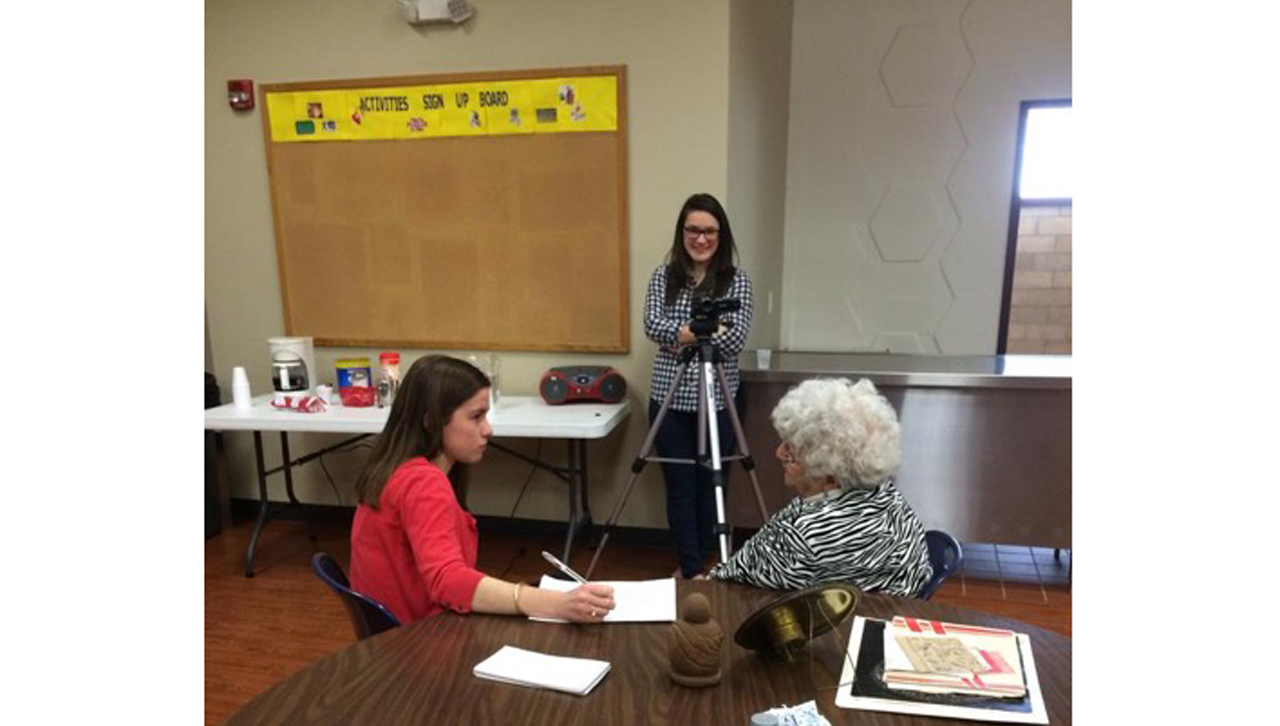Students Engage in Community-based Course Projects

A number of University of Scranton undergraduates have gotten the chance to help tell the stories of Scranton residents, thanks to projects offered in several courses.
During the past few semesters, three University professors – Assistant Professor of Communication Kimberly Pavlick, Ph.D.; Associate Professor of Psychology Jessica M. Nolan, Ph.D.; and Visiting Assistant Professor of History Aiala Levy, Ph.D. – have integrated community-based oral history projects into their coursework. For the most part, the projects center on the city’s senior citizen and immigrant populations.
Given she’s molding future journalists, Dr. Pavlick has long seen the benefits of requiring her students to practice their interviewing skills in real-world scenarios.
“You can’t teach journalism in a bubble,” Dr. Pavlick said. “I try to take them out into the community and get them out of that bubble.”
So, in addition to having students in her 200-level Newswriting course report on the University community, she has her 300-level News Reporting students conduct oral history projects within different subsets of the Scranton community. Among other groups, students have interviewed Syrian refugees and senior residents of Webster Towers in the city’s Hill Section.
“By being able to get the student out in the community, they learn about the greater Scranton community, which is important, because they’re residents of Scranton for four years,” said Dr. Pavlick, who coordinates the projects with University’s Director of Community and Government Relations Julie Schumacher Cohen. Their community partners include United Neighborhood Centers of Northeastern Pennsylvania.
In one example involving Webster Towers residents, students were paired with one or two interview subjects. Then, as part of their preparation, they were required to comb through the archives of the Lackawanna Historical Society in search of any useful information about their subjects.
Dr. Pavlick required the students meet with their subjects twice. The first visit is an informal session where the two parties get to know each other. The second visit is the formal interview, which is recorded and videotaped.
The finished transcript goes into the Historical Society’s archive, making it a legitimate piece of oral history.
Last spring, senior Journalism and Electronic Media major Luke Kropp, Laurel Run, interviewed two Webster Towers residents.
“It went well. They have a lot to talk about – a lot of experiences. It was really interesting to hear about their lives, going back to before World War II,” said Kropp. “It was a really great experience, one of the most interesting experiences I’ve had at the University.”
In addition to the applied-learning experiences gained by students and the recordings’ value to the Historical Society, the interviews make terrific keepsakes for the subjects’ family members, Dr. Pavlick said.
“They have such a rich history to share,” she said. “And you wouldn’t believe how beautifully and organically the conversations happen. There’s never any awkwardness. It’s just been such a rich experience.”
Dr. Pavlick has also conducted guest lectures on interviewing for students involved in Dr. Nolan’s and Dr. Levy’s oral history projects.
In the fall of 2016, students in Dr. Nolan’s 300-level Psychology of Diversity course conducted interviews with local Congolese refugees, and University workers from immigrant families.
“Ultimately, we want to see people as individuals, not just as members of a certain group,” said Dr. Nolan, who was inspired by Misericordia University professor Alicia Nordstrom’s Voices Project. “The focus was on getting students to understand experiences from people different from them, and from groups typically being associated as marginalized.”
This past fall, they interviewed members of Scranton’s Islamic and Jewish communities. Following the model established by Dr. Pavlick for her students, Dr. Nolan’s students met twice with their subjects.
The interviews were recorded, then from there the students turned them into first-person “mini-memoirs,” for which their task was to “get into character and feel what it would be like to be in that person’s shoes,” said Dr. Nolan.
“The people are very gracious, and I’m very grateful to all who are willing to share their experiences,” Dr. Nolan said. “Service-based learning is incredibly beneficial for students. I definitely plan to keep the project going.”
For her 100-level Colonial Latin America history course this past fall, Dr. Levy had her students interview members of Scranton’s Latino community. The idea sprung from a conversation she had with Historical Society Executive Director Mary Ann Moran-Savakinus.
Dr. Levy recruited most of the interview subjects, with assistance from United Neighborhood Centers.
“One of the goals was for the students to find connections between the past and the present,” Dr. Levy said. “And, of course, another goal was for them to better understand the people and the community.”
Just like the other courses, Dr. Levy’s students met twice with their subjects, most of whom were middle-aged. In addition to writing a report and reflection about the interviews, they turned the audio recordings and transcripts over to the Historical Society archives.
“As a historian, I’m definitely excited about future scholars being able to incorporate that into the history of Scranton,” Dr. Levy said. “I think the students feel like they’ve learned more about the community. And I think they were more comfortable with it than they expected. They found people who they could connect with. It would be a great project to continue.”
These projects are examples of community-based learning (CBL) activities that provide hands-on learning to students and help address community-defined needs, in these cases by producing new oral history material, facilitating meaningful exchange opportunities for senior citizens, and by giving voice to members of our region from refugee, immigrant and other minority groups. The University launched a new Office of Community-Based Learning in the fall of 2017, headed by Meghan Ashlin Rich, Ph.D., associate professor of sociology/criminal justice and women’s studies, aimed at further supporting faculty conducting CBL courses and strengthening the ways in which the campus engages with the hopes, concerns, challenges and opportunities facing Northeastern Pennsylvania.






